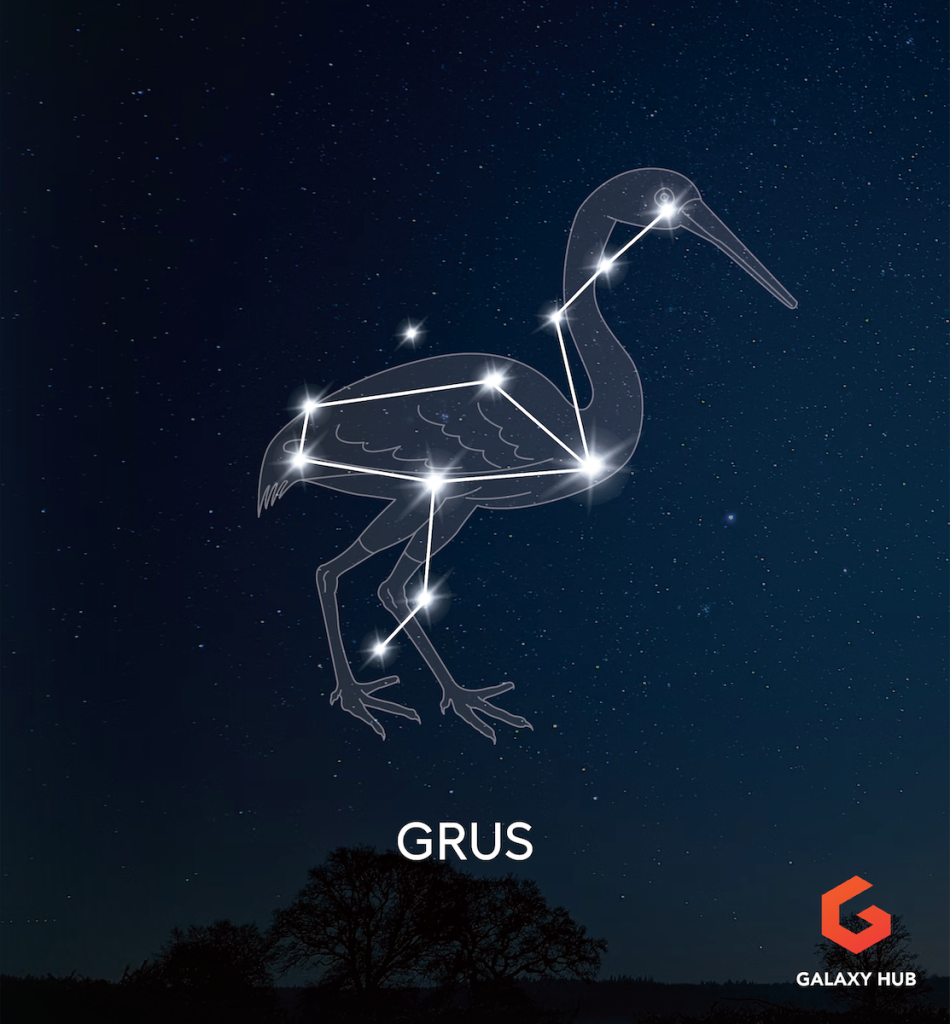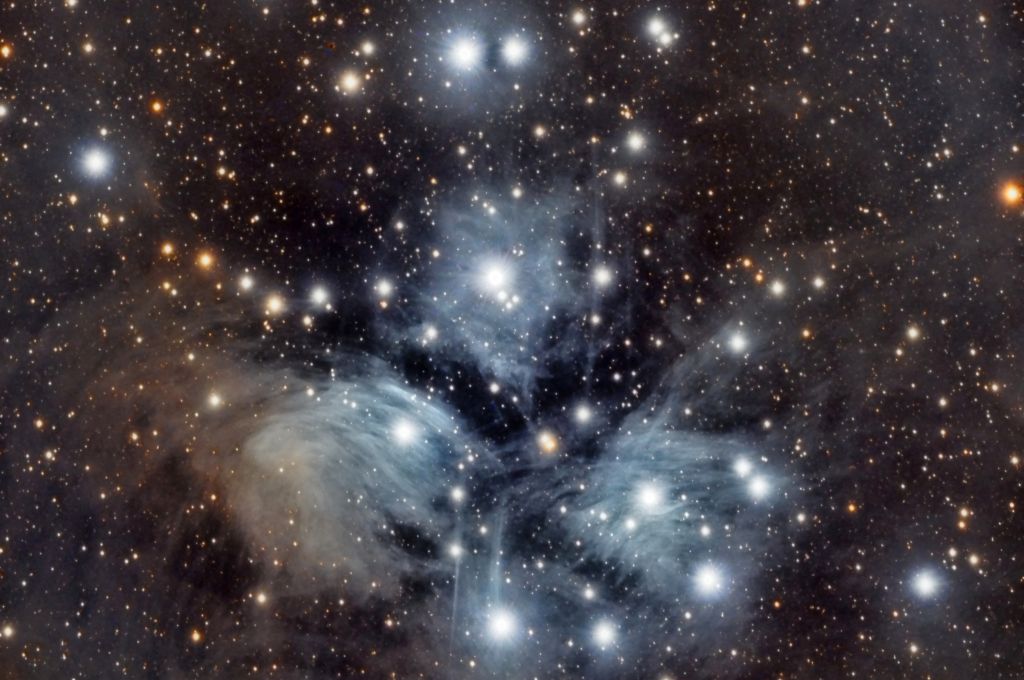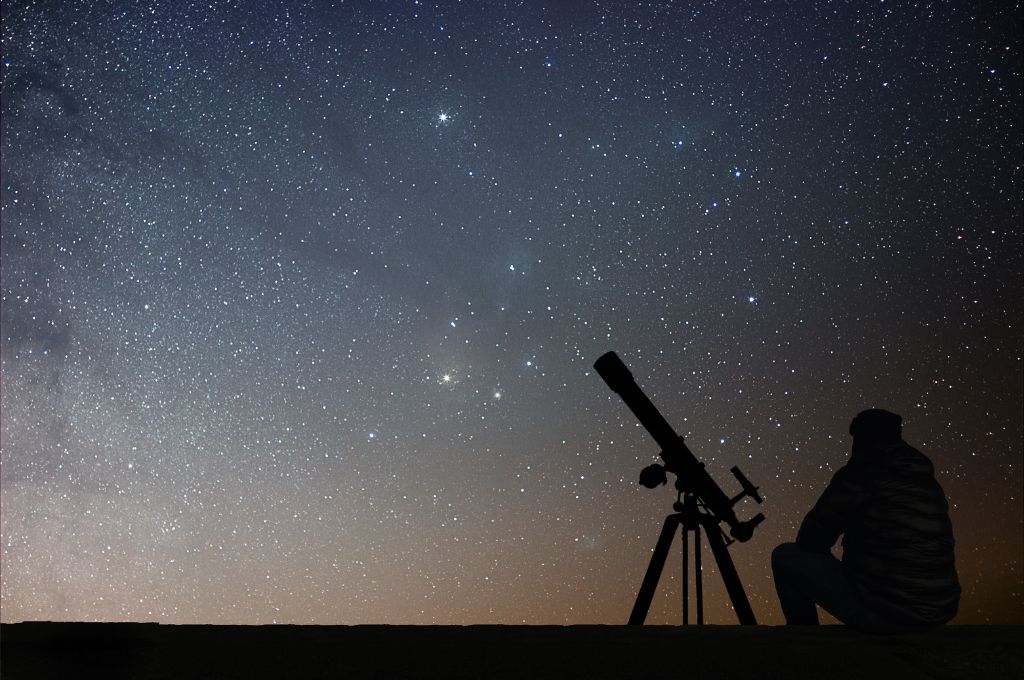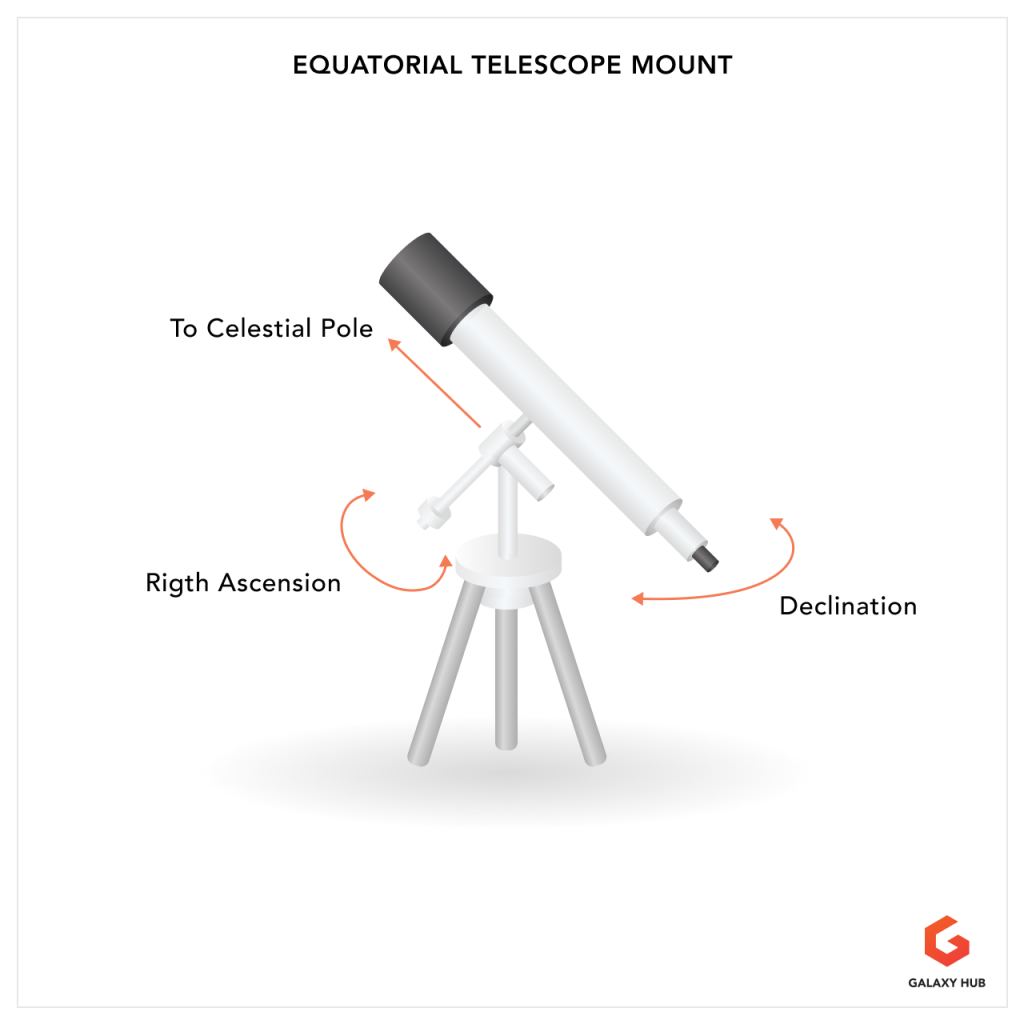Grus, the crane, is a mid-size constellation in the southern hemisphere. It’s a fun constellation to observe because of the colored stars – the crane’s eye, for example, is blue and its heart is red.
Grus is also home to a region of high galaxy density, and the constellation itself has quite a tumultuous history. Some of its stars were once part of the neighboring constellation Piscis Austrinus, a fish. Even after Grus was classified as its own constellation, it was briefly considered a flamingo and a heron by various astronomers until eventually its status as a crane became universal.
Together with the nearby constellations of Pavo (the peacock), Phoenix, and Tucana (the toucan), Grus is part of a group of constellations known as the Southern Birds.
Grus – and the Southern Birds in general – are best observed in October at latitudes from the South Pole to 34 degrees north.
Generally observers below a latitude of 33 degrees can see the full constellation in the sky. The crane has three named stars brighter than a magnitude 3 that make great targets for observation, and as well as a nebula and a group of interacting galaxies.
Gruis Key Data
Name
| Latin | English | Pronunciation | Genitive | Abbreviation |
| Grus | Crane | Grr-us | Gruis | Gru |
Location
| Hemisphere | Best Seen | R.A. | Declination |
| Southern | October | 21h 27m to 23h 27m | -36.31° to -56.39° |
Features
| Area | Size Rank | # of Messier Objects | # of Stars Brighter than Mag 4 | Brightest Star |
| 366 sq. Deg. | 45th | 0 | 6 | Alnair, Mag 1.7 |

Top Grus Facts
- Six star systems in Grus are currently thought to contain exoplanets.
- One of the nearest stars to Earth, a red dwarf named Gliese 832, is located in Grus. It’s famous for a Jupiter-sized exoplanet that orbits the star.
- In 2019, astronomers detected a star located in Grus that is traveling faster than any other star to date; current theories suggest it gained such a speed by interacting with the black hole at the center of our galaxy.
- Grus contains a brown dwarf located about 26 light years from Earth that is noteworthy for being one of the coldest star-like objects discovered to date.
- Grus contains stars marking the crane’s eye and heart.
- Grus contains the Grus Cloud, a high density region of galaxies containing several galaxy groups
Grus in Mythology
Because Grus was originally part of another constellation, Piscis Austrinus, there isn’t any specific western mythology associated with the constellation.
In general, cranes are associated with love and celebration of life in Greek and Roman mythology, while Chinese mythology considers cranes a symbol of eternal youth and happiness.
While all the stars that comprise Grus were likely not visible in ancient China, the section of the sky occupied by the crane lies in the quadrant of the Black Tortoise of the North, who holds the same name as a Taoist deity Xuanwu and is said to be a dark, mysterious warrior.

Grus in History
While some stars in Grus were too far south to be seen in ancient China, there is speculation that two of its stars formed part of a Chinese tub-shaped asterism.
In western catalogues, Grus was originally the curved tail of Piscis Austrinus, the fish. Dutch astronomer Petrus Plancius took some of the stars off the tail of the fish to make it straight.
Then, based on the observations of two Dutch explorers and celestial cartographers who sailed on the first Dutch trading expedition to the East Indies, he crafted the independent constellation Grus from those former tail stars.
The first ever depiction of Grus was on a 1598 celestial globe published by Plancius and Jodocus Hondius, a Dutch engraver.
Five years later, Grus made its first debut in a celestial atlas – the famous Uranometria, published by German cartographer Johann Bayer in 1603. During the early 1600s, Grus appeared in additional publication – Cosmographiae Generalis by Paul Merula – and on an additional globe labeled as a flamingo, but that label didn’t stick.
When and How to See Grus
The borders of Grus were defined by Eugene Delporte in 1930.
The Belgian astronomer considered the crane’s borders as a polygon of six segments, and the entire constellation is visible to observers south of a latitude of 33 degrees north. Observers anywhere in the southern hemisphere have an excellent view of the constellation, and it is best seen during the month of October.
It’s easy to spot the two brightest stars in Grus – Alnair and Beta Gruis. First, locate the Great Square of Pegasus and draw an imaginary line through Fomalhaut – one of the brightest stars in the sky, which lies in the constellation Grus was formerly a part of, Piscis Austrinus.
This line will lead you directly to Alnair, the brightest star in the constellation and the left wing of the crane, and subsequently Beta Gruis, considered to be the crane’s heart. Above these you will see Aldhanab, a fairly bright blue-white star marking the crane’s eye.

Grus’ Notable Stars
| Bayer/Gould Designation | Name (s) | Mag | R.A. | Dec. | Distance (LY) | Notes |
| Alpha | Alnair | 1.74 | 22h 08m 14s | -46° 57’ 40” | 101 | Grus’ brightest star – a blue-white subgiant and the left wing of the crane |
| Beta | Tiaki | 2.15 | 22h 42m 40s | -46° 53’ 04” | 177 | The crane’s heart, a red giant star |
| Gamma | Aldhanab | 3 | 21h 53m 56s | -37° 21’ 53” | 211 | The crane’s eye, a blue-white subgiant |
| Delta | Delta1 Gruis | 3.97 | 22h 29m 16s | -43° 29’ 44” | 309 | Double star with Delta2 Gruis, and a binary star with a 12.8 magnitude companion |
| Delta | Delta2 Gruis | 3.99 – 4.20 | 22h 29m 45s | -43° 44’ 57” | 356 | Double star with Delta1 Gruis |
| Epsilon | Epsilon Gruis | 3.47 | 22h 48m 33s | -51° 21’ 01” | 129 | Blue-white subgiant and suspected variable star |
| Gliese 832 | Gliese 832 | 8.66 | 21h 33m 34s | -49° 00’ 32” | 16.2 | Faint red dwarf with notable exoplanets in orbit |
Alnair
Forming Grus’ left wing, Alnair is the brightest star in the constellation and is one of eighteen southern-sky stars recognized internationally for use in navigation. This blue-white subgiant’s name comes from the Arabic “Al Nair,” which means “the bright one.” Alnair is over 500 times brighter than the sun and over 3 times as wide.
Alnair is a main sequence star, but it has nearly exhausted the supply of hydrogen in its core. It is also noted for its incredibly rapid rotational speed – 215 km/s.
Astronomers think Alnair could be a part of the AB Doradus moving group, which consists of thirty stars of the same age and composition that move through space in the same way, suggesting a common origin. Alnair has had several names historically including the name Zeta Centauri, and “Alnair” wasn’t settled on until 2016.
Tiaki
A red giant star that is just over twice as massive and half as hot as the sun, Tiaki is crane’s red heart. Its name is traditional Tuamotuan, from an archipelago in French Polynesia. The giant has a radius of 180 times that of the sun, and it is 2,500 times more luminous.
Tiaki is an interesting star to observe, because it is a semi-regular variable star. It undergoes periods of time where its luminosity changes regularly over 37 days, but it also undergoes intervals of irregular change. Alnair and Tiaki form a triangle with Delta Gruis, a naked-eye double star whose stars are around magnitude 4.
Aldhanab
This blue-white subgiant makes up the crane’s eye in the Grus constellation. Aldhanab, known in Arabic as Al Dhanab, is a unique star because it is 390 times as luminous as our sun, except most of its light emitted is ultraviolet rather than visible. It has a somewhat rapid rotation of 57 km/s (compared to our sun’s 2 km/s).
Delta Gruis
Delta Gruis forms a triangle with the constellation’s two brightest stars, Alnair and Tiaki. Delta1 Gruis is an optical double star with Delta2 Gruis, and under ideally dark conditions, observers can distinguish both with the naked eye.
Delta1 Gruis is a yellow star several hundred times more luminous than the sun, and it is also a binary star. Its companion can only be seen through a good telescope, since it has a magnitude of 12.8. If seeking to observe this binary system, note that the two stars have an angular separation of 5.6 arc seconds.
Delta2 Gruis is not part of a binary system, but does have a visible double companion that is not visible with the naked eye – a 9.71 magnitude star located 60.4 arc seconds Delta2 is a red giant star with a magnitude that varies between 3.99 and 4.20. It’s a pulsating variable star with several different periods.
Epsilon Gruis
Epsilon Gruis is a blue-white subgiant and suspected variable star that is visible to the naked eye. Like some of the other stars in Gruis, it has a very fast rotational velocity. This star’s rotational speed is 235 km/s – enough to give it what astronomers call an equatorial bulge and an oblate shape.
Epsilon Gruis is also noteworthy for several other reasons. First, it is a suspected variable star, and it also likely possesses a companion star. The companion is thought to be a somewhat active star that is emitting x-ray radiation. Epsilon Gruis itself is emitting more infrared radiation than is expected for a star of its nature, which makes astronomers think that it may be orbited by a disk of dust.
Gliese 832
Though too faint to be seen with the naked eye, Gliese 832 is quite a famous star. At about 9.5 billion years of age, it is a fairly old red dwarf located a mere 16.2 light years from Earth. Gliese became well known when astronomers discovered a Jupiter-sized exoplanet (Gliese 832 b) orbiting the star in 2008.
Years later in 2012, scientists made an even more exciting discovery: another exoplanet, Gliese 832 c, is a tidally-locked planet that is orbiting inside the star’s habitable zone. That means that it could possibly contain water and/or life, if other conditions are met! It is currently considered the closest potentially-habitable extrasolar planet to Earth.
Grus’ Deep Sky Objects
| Object | Name(s) | Type | Mag | R.A. | Dec. | Distance (LY) | Min. Equipment |
| IC 5184 | Spare Tyre Nebula | Planetary Nebula | 16.5 | 21h 59m 35s | -39° 23’ 08” | 3000 | Large Telescope |
| NGC 7213 | N/A | Lenticular Galaxy | 10.1 | 22h 09m 16s | -47° 09’ 59” | 72 million | Medium Telescope |
| IC 1459 | N/A | Giant Elliptical Galaxy | 10 | 22h 57m 11s | -36° 27’ 44” | 85 million | Medium Telescope |
| NGC 7424 | N/A | Barred Spiral Galaxy | 11 | 22h 57m 18s | -41° 04’ 14” | 37.5 million | Medium Telescope |
| NGC 7552 | N/A | Barred Spiral Galaxy | 11.2 | 23h 16m 11s | -42° 35’ 05” | 56 million | Medium Telescope |
| NGC 7582 | N/A | Spiral Galaxy | 11.37 | 23h 18m 24s | -42° 22’ 14” | 69 million | Medium Telescope |
Nebulae
IC 5184
IC 5184 is nicknamed the Spare Tyre Nebula for its donut-like shape.
Discovered by an amateur astronomer in 1894, it can be found 1 degree west of the star Lambda Gruis. It is famed for being one of the fastest known expanding nebulae, with its gases shooting outwards at a rate of 50 km/s.

Galaxies
NGC 7213
NGC 7213 is a magnitude 10.1 lenticular galaxy, which indicates its shape is somewhere in between that of an elliptical galaxy and a spiral galaxy. At 75 million light years away, the galaxy is around 75,000 light years across. Located near Alnair, NGC 7213 is part of a group of over 10 galaxies.
It is an active galaxy, somewhere between a Type I Seyfert Galaxy and a LINER galaxy, and has been found to emit a small and fluctuating amount of X-ray radiation. Though there are no signs of this when observing visually, NGC 7213 shows evidence of a past galaxy collision or merger when viewed with longer wavelengths of light.

IC 1459
IC 1459 is a giant elliptical galaxy around 130,000 light years in diameter. It is an active galaxy whose 199 globular clusters have been imaged by the Hubble Space Telescope.
Its galactic core has been observed to contain a group of stars with a fast counter-rotation to the galaxy itself, indicating that they may have an origin outside the galaxy.
IC 1459 is the brightest galaxy in a group of galaxies bearing its name, and it is also located at the center of the group. The IC 1459 group is part of the Grus Cloud – a general area marked by a high concentration of galaxies.

NGC 7424
NGC 7424 is considered a “grand design” galaxy due to its incredibly well-defined spiral arms. This, along with the fact that it is thought to resemble our own Milky Way galaxy, makes it an intriguing target for observation.
While it is considered part of the IC 1459 Grus Group of galaxies, astronomers suspect that NGC 7424 is a field galaxy, meaning it is not bound gravitationally to a group. The galaxy contains a rare Type IIb supernovae (called SN 2001ig) on its outer edge.
NGC 7552
NGC 7552 is an 11.2 magnitude barred spiral galaxy that is part of a group of galaxies known as the Grus Quartet. It exhibits a high amount of starburst activity due to its interaction with another galaxy in the group – NGC 7582.
NGC 7552 is an interesting target to observe because of two characteristics: first, it is seen nearly head-on; second, its spiral arms come together to form what is almost an outer ring of stars.
NGC 7582
NGC 7582 is another member of the Grus Quartet. A spiral galaxy of magnitude 11.37, it is an active Seyfert 2 galaxy with a similar diameter to our own Milky Way – 100,000 light years. It is sometimes considered part of the Grus Triplet with two other galaxies, NGC 7590 and NGC 7599, because the three are separated by only 10 arc minutes in the sky. This makes it a neat target for observation; if you find this galaxy, you know a couple more are very close by.






